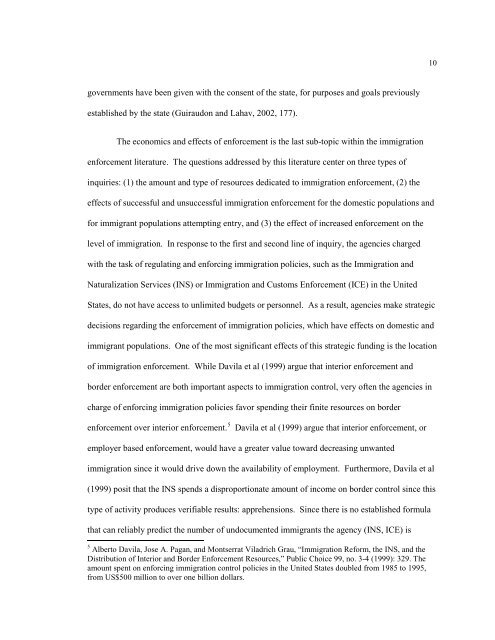Complete Thesis_double spaced abstract.pdf
Complete Thesis_double spaced abstract.pdf
Complete Thesis_double spaced abstract.pdf
You also want an ePaper? Increase the reach of your titles
YUMPU automatically turns print PDFs into web optimized ePapers that Google loves.
governments have been given with the consent of the state, for purposes and goals previously<br />
established by the state (Guiraudon and Lahav, 2002, 177).<br />
The economics and effects of enforcement is the last sub-topic within the immigration<br />
enforcement literature. The questions addressed by this literature center on three types of<br />
inquiries: (1) the amount and type of resources dedicated to immigration enforcement, (2) the<br />
effects of successful and unsuccessful immigration enforcement for the domestic populations and<br />
for immigrant populations attempting entry, and (3) the effect of increased enforcement on the<br />
level of immigration. In response to the first and second line of inquiry, the agencies charged<br />
with the task of regulating and enforcing immigration policies, such as the Immigration and<br />
Naturalization Services (INS) or Immigration and Customs Enforcement (ICE) in the United<br />
States, do not have access to unlimited budgets or personnel. As a result, agencies make strategic<br />
decisions regarding the enforcement of immigration policies, which have effects on domestic and<br />
immigrant populations. One of the most significant effects of this strategic funding is the location<br />
of immigration enforcement. While Davila et al (1999) argue that interior enforcement and<br />
border enforcement are both important aspects to immigration control, very often the agencies in<br />
charge of enforcing immigration policies favor spending their finite resources on border<br />
enforcement over interior enforcement. 5<br />
Davila et al (1999) argue that interior enforcement, or<br />
employer based enforcement, would have a greater value toward decreasing unwanted<br />
immigration since it would drive down the availability of employment. Furthermore, Davila et al<br />
(1999) posit that the INS spends a disproportionate amount of income on border control since this<br />
type of activity produces verifiable results: apprehensions. Since there is no established formula<br />
that can reliably predict the number of undocumented immigrants the agency (INS, ICE) is<br />
5 Alberto Davila, Jose A. Pagan, and Montserrat Viladrich Grau, “Immigration Reform, the INS, and the<br />
Distribution of Interior and Border Enforcement Resources,” Public Choice 99, no. 3-4 (1999): 329. The<br />
amount spent on enforcing immigration control policies in the United States <strong>double</strong>d from 1985 to 1995,<br />
from US$500 million to over one billion dollars.<br />
10














![Completed Thesis to Grad Studies[Final3].pdf](https://img.yumpu.com/17538645/1/190x245/completed-thesis-to-grad-studiesfinal3pdf.jpg?quality=85)
